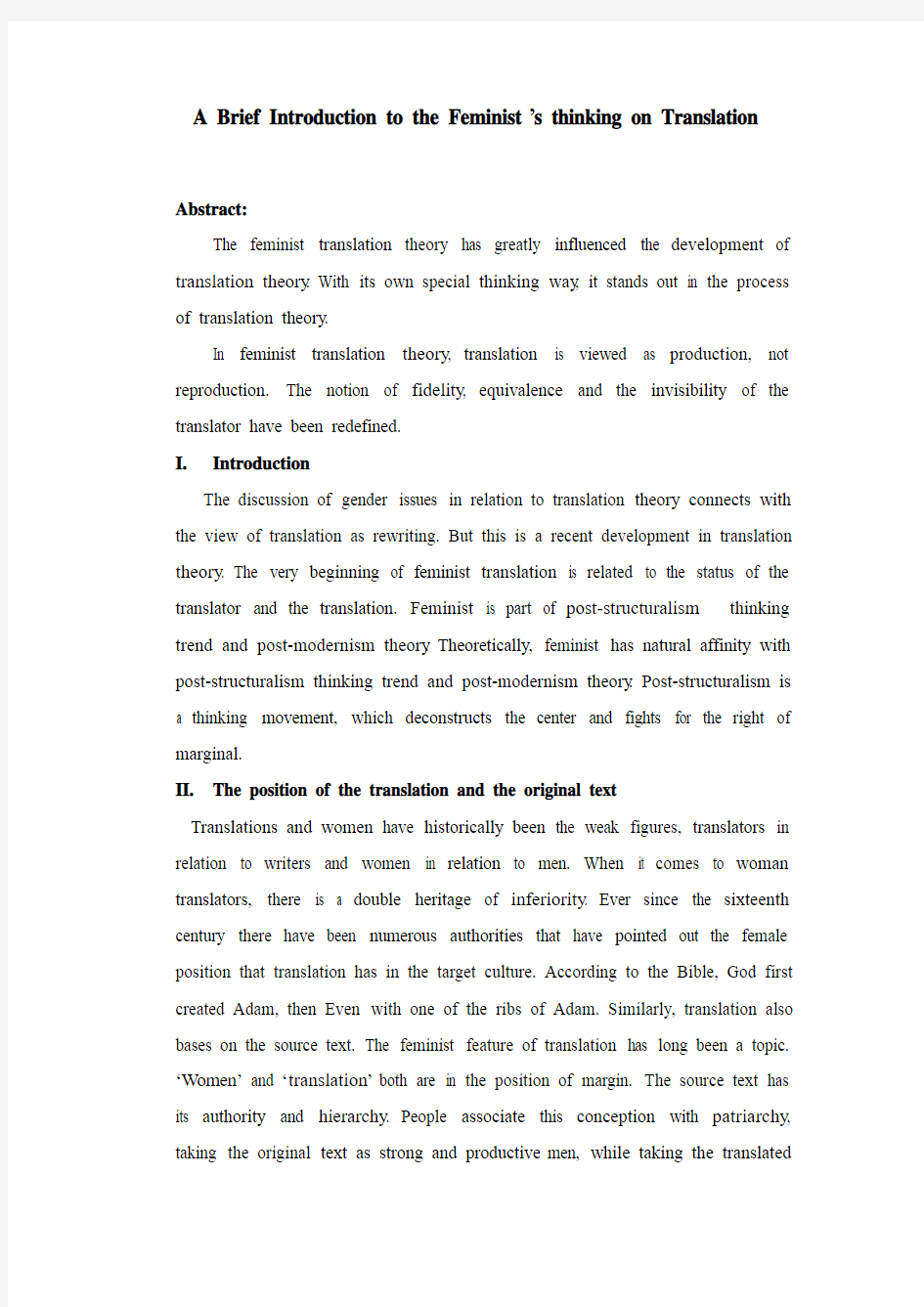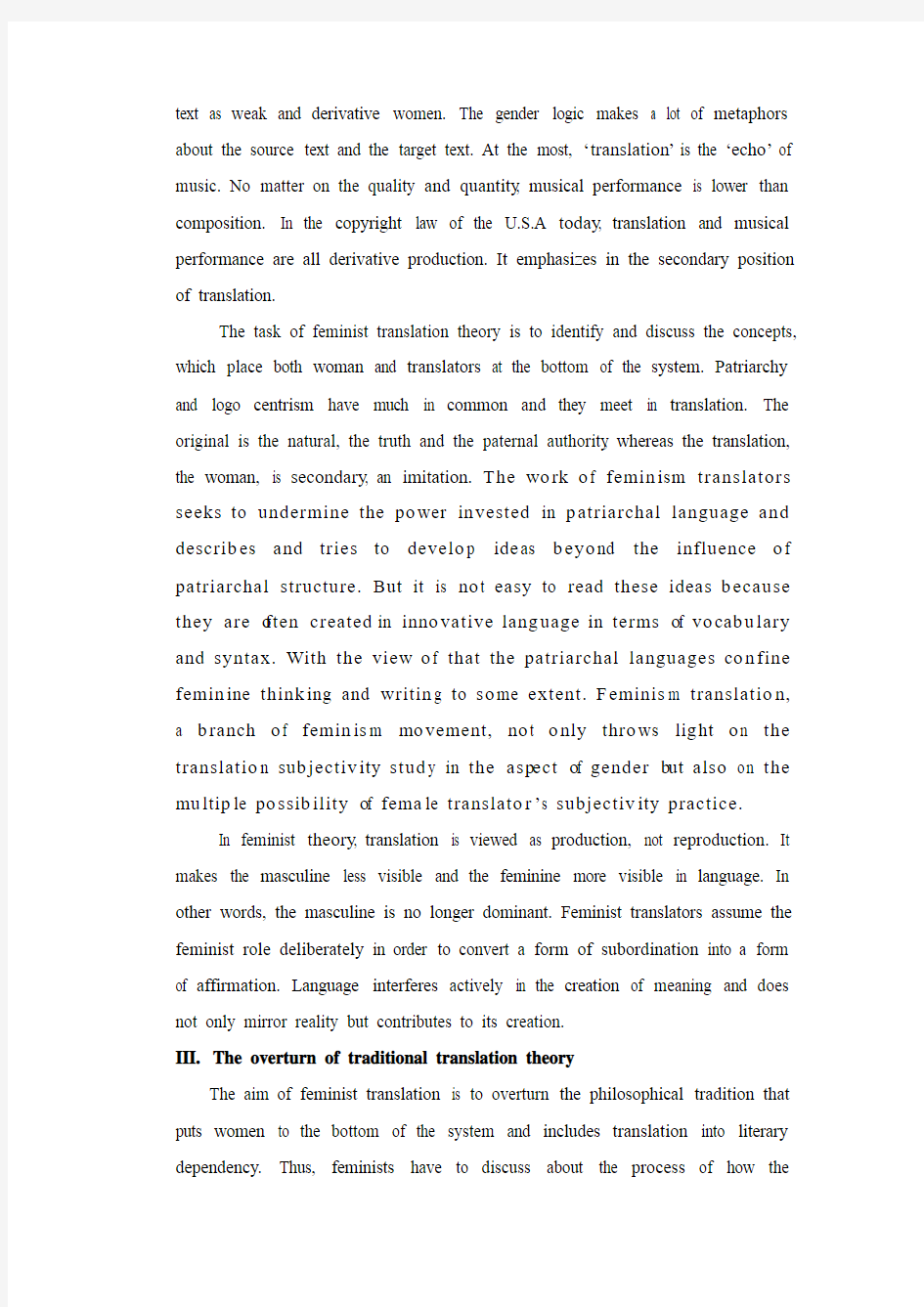

A Brief Introduction to the Feminist’s thinking on Translation
Abstract:
The feminist translation theory has greatly influenced the development of translation theory. With its own special thinking way, it stands out in the process of translation theory.
In feminist translation theory, translation is viewed as production, not reproduction. The notion of fidelity, equivalence and the invisibility of the translator have been redefined.
I.Introduction
The discussion of gender issues in relation to translation theory connects with the view of translation as rewriting. But this is a recent development in translation theory. The very beginning of feminist translation is related to the status of the translator and the translation. Feminist is part of post-structuralism thinking trend and post-modernism theory. Theoretically, feminist has natural affinity with post-structuralism thinking trend and post-modernism theory. Post-structuralism is a thinking movement, which deconstructs the center and fights for the right of marginal.
II.The position of the translation and the original text
Translations and women have historically been the weak figures, translators in relation to writers and women in relation to men. When it comes to woman translators, there is a double heritage of inferiority. Ever since the sixteenth century there have been numerous authorities that have pointed out the female position that translation has in the target culture. According to the Bible, God first created Adam, then Even with one of the ribs of Adam. Similarly, translation also bases on the source text. The feminist feature of translation has long been a topic. ‘Women’ and ‘translation’ both are in the position of margin. The source text has its authority and hierarchy. People associate this conception with patriarchy, taking the original text as strong and productive men, while taking the translated
text as weak and derivative women. The gender logic makes a lot of metaphors about the source text and the target text. At the most, ‘translation’is the ‘echo’ of music. No matter on the quality and quantity, musical performance is lower than composition. In the copyright law of the U.S.A today, translation and musical performance are all derivative production. It emphasizes in the secondary position of translation.
The task of feminist translation theory is to identify and discuss the concepts, which place both woman and translators at the bottom of the system. Patriarchy and logo centrism have much in common and they meet in translation. The original is the natural, the truth and the paternal authority, whereas the translation, the woman, is secondary, an imitation.The wo rk o f femin ism translators seeks to undermine the po wer in vested in p atriarchal language and describ es and tries to develo p ide as b eyo nd the influence o f patriarchal structure. But it is no t easy to read these ideas b ecause they are o ften created in inno vative lang uage in terms o f vo cab u lary and syntax.With the view o f that the patriarchal languages co n fine femin ine think ing and writin g to so me extent.F eminis m translatio n, a b ranch o f femin is m mo vement, no t o nly thro ws lig ht o n the translatio n sub jectiv ity stud y in the asp ect o f gender b ut also o n the mu ltip le po ssib ility o f fema le translato r’s subjectiv ity practice.
In feminist theory, translation is viewed as production, not reproduction. It makes the masculine less visible and the feminine more visible in language. In other words, the masculine is no longer dominant. Feminist translators assume the feminist role deliberately in order to convert a form of subordination into a form of affirmation. Language interferes actively in the creation of meaning and does not only mirror reality but contributes to its creation.
III.The overturn of traditional translation theory
The aim of feminist translation is to overturn the philosophical tradition that puts women to the bottom of the system and includes translation into literary dependency. Thus, feminists have to discuss about the process of how the
translation is feminized and deconstruction of the traditional translation theory, which is based on the structuralism, and gender logic, which constitutes its philosophical basis. They put forward doubts on the gender, role of translation and the ’fidelity’ of the rule and the functions and roles of language. Feminist thinks that the original and the translated text is equivalent. Language not only reflects the truth of gender discrimination and also emphasizes on the gender discrimination. Translation is not just mechanical transformation. It is creative work which relates to cultural intervention and coordination. Feminist translation theory gave fresh impetus to the ‘cultural turn’of translation studies for its political discourse. It establishes the philosophical basis for criticizing structuralism-based translation theories from the perspective of the nature of language, the ethics of translation, and the relationship between the source language text and the target language text.
IV.The battle for women to get the speaking right
Before the nineteenth century women in the Western world were restricted to the domestic areas of life and prohibited from publicly displaying their interests in culture. The prohibition referred primarily to the activity of writing and publishing literature. In Europe, from the beginning of mid-century, translation has been the way for women to enter into the literary world. Excluded from the privileges of authorship, women turned to translation as a form of public expression. Translation allowed women to take part in literary culture without openly challenging either tradition or male domination of that culture. It provided an opportunity to be involved in text production and to manifest some degrees of creativity.
From the 1960s to 1990s, translation theory has its fixed thinking way, because of influence of structuralism. Language was seen as an objective and value-free symbolic system and a tool which human beings used to know and master the world. It is analogous to mathematical symbolic system which is the symbol of rationalism and regularity. This kind of translation view bases on a transparent poetic theory and restrains its research focus to the transformation of
language, follows the research tradition of natural science, discards the subjective and pursues the subjective description of absolute neutrality. It aims at providing ‘scientific‘explanation for translation research, but when it’s applied to the explanation of practical use of language, many weak points appear.
Feminists acclaim that structuralism pay much attention to the universality and objectivity and ignores difference, which in fact reveal the gender discrimination issues. The radicals of feminism point out that language is the fundamental cause of feminine discrimination, while to reformationists; Language at the least reflects the social fact that women are discriminated. Feminism has its doubts on the feature of tool and the media of the language. Feminists conclude that gender discrimination is not an ideological but a language issue. They state that male-dominated language has been the reflection of the male experience, and has formed its rules. Although there is no strict grammatical gender, but it takes men as a general unmarked form, or the general signified. For example,
A student who pays his own ways gets the tax credit.
Translation also is the critical means of enforcing language reform for feminists. They combine the decomposition of masculinity words and the deconstruction of he traditional translation theory. Feminists first cast doubts on the grammatical gender and challenge the male-dominated grammatical regulation in that grammatical rules say that male words are hyponym of the female-words. Feminist theory meets translation in the emphasis on the polyphony of the translated text. The text foregrounds the reflective elements of the rewriter’s discourse. In opting for a less fluent language in the translation than in the original text, women call attention to their own intervention in the target text. In its attention to gender, feminist translation seeks to draw attention to the patterns of patriarchal domination, using language to draw attention to the patterns of patriarchal oppression. Inevitably, a translated text reflects the translator’s reading and this is a factor, which empowers the translator.
V.The limitations of feminist translation theory
Feminist translation theory has widened the visible domain of translation
research, especially for the explanation of the right relationship and the deconstruction and overturn of the hierarchy, for the affirmation and support of the difference, making the feminist translation theory, deconstructionist translation theory and post-colonist translation theory together. Since feminist translation theory was introduced into translation theory, it has opened new research fields gradually, and flourished till 1990s. The explanation of difference successfully deconstructs the original text and the dominant position and provides new theoretical basis for the reflection of the equivalent in the traditional translation theory, cultural difference, and subjectivity of the translator and the nature of language. But there are many schools of feminism whose view are too radical and regard the overturn of the traditional translation theory based on the structuralism as the end aim, irrationality as rationality. To fulfill its political aim, they pay too much attention to the manipulation of language and intervention of the translator. In some way, it distorted the nature of the translating activities; inevitably, there are criticisms on feminist translation theory.
VI.Conclusion
It is not accidental to discuss about the matter of translation and gender in cultural conceptualization. Feminist gives many revelations for the translation research. Historically speaking, women’s association with translation originated from a social prohibition.